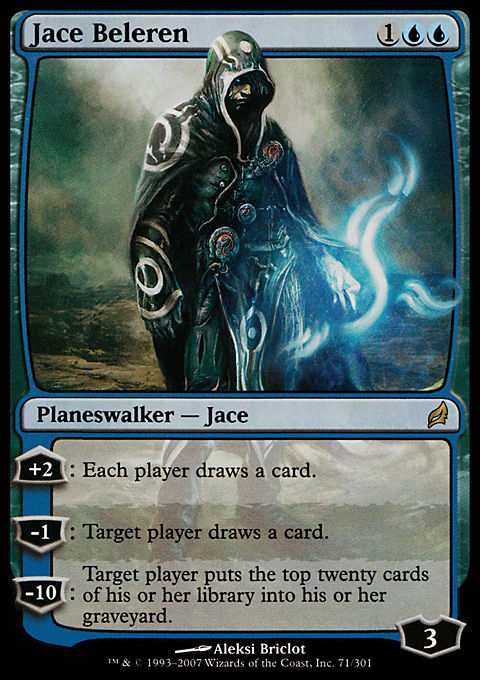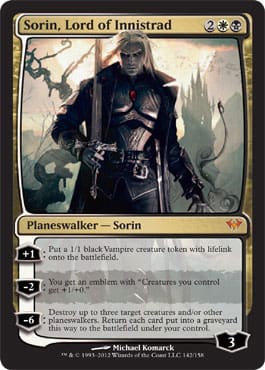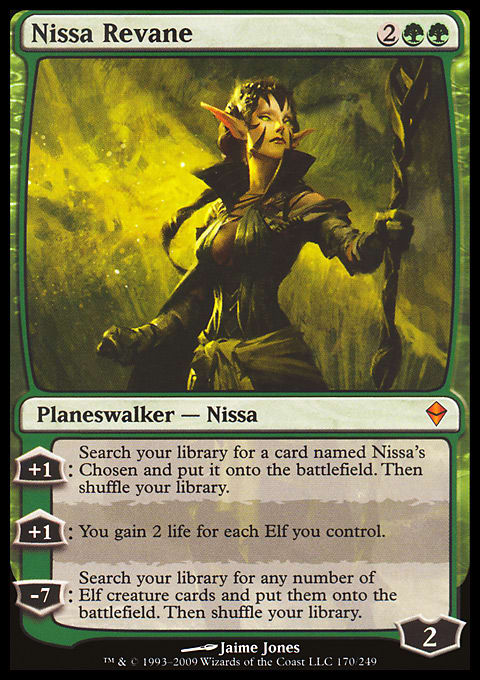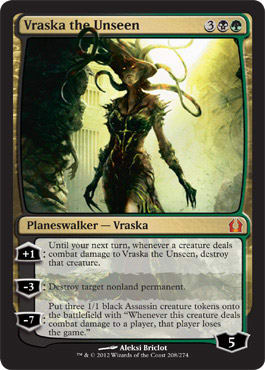When Planeswalkers debuted in Lorwyn, we really didn’t know what to make of them. Usually when new cards come out in a new set, we have an established track record of cards to compare them to. I can tell approximately how good the latest cards to see release will play (particularly in Casual Land) because I have more than twenty years’ worth of cards to compare them to. Only a few times has something so new debuted that we really didn’t have any idea of how it would play. Equipment was one instance, and we’ve had a handful of effects that are really brand new (like indestructible or a card like Mindslaver).
But Planeswalkers? They were totally new. How would they play out? It was a guessing game!
For a while, they weren’t targeted that much in the multiplayer games I rocked, both with my regular group and in pickup games encountered at the store or online. The general (admittedly unspoken), casual consensus seemed to have a maxim saying, “Prove it!”
Then, the cards began to do some problematic things. Liliana Vess, if left unchecked, was a discard machine that could tutor or reanimate an entire fleet of creatures under your control. Yeah, she’s nasty! Chandra Nalaar was getting up there in loyalty and then spanking someone’s board position. Garruk Wildspeaker was untapping crazy lands like Maze of Ith and Gaea's Cradle while dropping tokens and Overruns everywhere. They proved it all right!
And then there was an overcompensation. Both in my playgroup and online, there seemed to be a sort of communal death-on-sight metric that blew up every Planeswalker with alacrity. They were countered, Vindicated, and burned with verve.
It didn’t take too long for the pendulum to swing back to the middle as we figured out what Planeswalkers could do and what they couldn’t. We had enough experience with them to matter, and we began to gain a better sense of newer ’Walkers that were to be released.
How are Planeswalkers great for your game? How do they suck? Now we know. Now we can assess the basic multiplayer theory of Planeswalkers and use that to assess any new cards that are released. Moreover, we can also use this understanding to look backward and reveal really strong ’Walkers for your decks that might be hiding. So let’s delve into Planeswalker theory!
Advantage #1: Cockroach Level 6
When Anthony Alongi debuted his multiplayer hall of fame, the concept of repeatable effects was missing. He had created a variety of elements to assess the individual layers of how a card operated in multiplayer space. For example, does a card scale in power based on the number of opponents? (That’s a pigeon.) Does a card warn people away from attacking you? (That’s a rattlesnake.)
Later on, he realized that cards, such as Volrath's Stronghold, that can use their effects turn after turn have an enhanced ability in multiplayer that was not recognized by his elements. So he added another—the cockroach—to assess them.
Last year, in 2014, I had the absolute honor to work on updating Alongi’s Hall of Fame for Wizards of the Coast’s website. I was specifically assigned to white, where I wrote about white and slaved over the ratings. The Hall ended before Planeswalkers ever were released. So, what white card did Anthony think had the best cockroach rating of all time?
And now you can see why. After all, you can churn 3 mana into the thing anytime you want and produce a Solider token—you can block an attacker or make an instant army, and our Soldiers are rocking vigilance as well, so they gain an added bonus. And you know what? He was right! There was no better cockroach card in white up until that time. In our multiplayer group, virtually every green deck, for years, ran Centaur Glade. Dragon Roost? That was a common addition as well (but so expensive that it wasn’t the auto-include the Glade was). Mobilization was in virtually every white deck, too. It’s a nasty, repeatable, card. And you know what?
It looks downright homely compared to the nasty repeatability of Planeswalkers. Compare Mobilization to . . . say . . .
The Champion costs 3 more mana, sure. But then your investment is over, and you never need to spend another mana. You can churn out three Soldiers every turn, and you grow Elspeth, Sun's Champion at the same time. Just in terms of Solider-making alone, Elspeth smashes the Mobilization. And then add in the other benefits of repeatability to the mix.
The mana-free ability to do a strong ability turn after turn after turn gives you a lot of power. The cockroach rating of every Planeswalker seems to start at 6 (Alongi rated on a scale of 1 to 7) because it’s that good. Understanding how useful a ’Walker is has to start with this concept of repeatability.
Advantage #2: Card Advantage
Many Planeswalkers provide a level of card advantage, which is key to unlocking how they work. One easy example is the ’Walker that can make token creatures. As those creatures trade with “real” creatures, you are racking up card advantage. If they trade with removal spells, the same occurs. If you force your opponent to play Pyroclasm or Drown in Sorrow to clean out your many Vampires that Sorin, Lord of Innistrad made, you are one up on the card-advantage front.
Is your ’Walker destroying permanents? Someone like Vraska the Unseen, who can destroy a nonland permanent, provides card advantage. Not only have you blown up that opposing dork, but you also have a nice card still in play.
And while we are talking about card advantage, Jace wants to say hello to everyone out there. There are a lot of Jaces that just draw you cards outright. You’ll find a few other ways that ’Walkers can yield card advantage, and that creates a strong board position for you.
Advantage #3: Versatility 101
One of the reasons I led with the Mobilization-versus-Elspeth comparison was that I also want to use it here as an example of the enhanced versatility that ’Walkers have. Very few permanents have as many useful abilities as a ’Walker, so you have options. Those open up more ways to take care of stuff. Our good Champion can also do her best Retribution of the Meek impression, and she can even pump your creatures permanently.
These added layers are vital to understanding how useful a given ’Walker is. ‘Walkers that have a lot of strong abilities, such as Liliana Vess, end up getting better because there are no bad abilities. Liliana can discard, tutor, or reanimate. All three are useful in every metagame and in virtually every deck.
As you look around, you’ll notice that ’Walkers that have one (or more) abilities that are pretty specific—or weak—tend to be those that lack versatility, and as a result, they are are not as good. Nissa Revane is a good example since her +1 ability only works when you have Nissa's Chosen in your deck and her second +1 ability only works when you have Elves. She requires a certain deck to run her.
Now, what problems do ’Walkers have?
Disadvantage #1: Every Color has an Answer
When I want to talk about the relative value of enchantments or artifacts at the multiplayer table, I need to point out that some colors are weak at answering them. Black has little to do with your dumb artifacts and enchantment, and red can only look at your enchantment and swear. If blue can’t counter or steal it, it’s usually out, too.
But for ’Walkers, everyone can take them out because everyone has creatures to attack them. Meanwhile, you have red’s burn to blow them up alongside stuff like green’s Desert Twister–style effects. Black can burn, blue can counter or steal, and bounce is more effective since you can reset counters. Black can burn, Hero's Demise, or use stuff like Aether Snap or Vampire Hexmage. In fact, I have recently (in the last couple of years or so) become enamored with Hex Parasite.
Since everyone has answers to your Planeswalkers, you can’t grow too comfortable with them, and you can’t rely on them overly much. They will get offed. Every single deck can destroy them, no matter what type of deck or what color it is.
Disadvantage #2: Card Disadvantage
This is a secret problem with Planeswalkers that is sort of a corollary to above that I haven’t seen a lot of people discuss.
Every single deck that you face has a chance to turn every single ’Walker you play into card disadvantage. What do I mean? Well, imagine that you play Random McWalker. Then your foes decide to attack McWalker. And over the course of one or two attacks, they strip off counters and take down McWalker before the card advantage began. Other that being a glorified and expensive Fog, you really haven’t accomplished much, and you are down a card.
Because creatures-attacking is a route to destroy your Planeswalker, and since virtually every deck conceived by Magicdom has some sort of creatures attacking in it, your erstwhile ally can be killed before doing anything, and it’s a loss of a card, just like playing that Fog is. And if your Chandra Nalaar is a 5-mana Fog that loses you a card after shooting Jimmy for 1 damage, that’s important to know up front.
If you want to counter this, you need to gain a card from a Planeswalker immediately in order to keep the equilibrium. Sure, play that Chandra Nalaar, but just pull off 3 counters to kill that X/3 dork your foe has. Now if Chandra is attack-killed, you at least kept things even.
In summation, when looking at ’Walkers, you need to understand that:
- They are potent cockroaches with an inherent recursive ability.
- Many have the ability to provide card advantage.
- They have a good deal of versatility.
- Any deck and color can answer them.
- They can be card disadvantage if not prepared for.
When looking at any given ’Walker, those are the rules in place of how they operate in theory.
I’ll even give you a few examples of older cards to see how those principles work in action in assessing these rules.
Vraska the Unseen
Because of her +1 ability, Vraska is the only Planeswalker that is not innate card advantage when it is activated. If opponents attack her, they lose their stuff. That’s a nasty swap. So she hedges one of the weaknesses of her type right there.
Then, she offers a powerful Vindicate-style ability. The only thing she can’t kill is lands. She can even take out opposing Planeswalkers! This gives her immediate and long-lasting ability for card advantage.
Finally, her ultimate can churn out a trio of 1/1 Assassins all ready to kill players. Because her first ability can stonewall attackers, she has a better chance of making it to ultimate than a lot of folks. And these tokens increase her card-advantage potential considerably, as people will use pinpoint removal to kill Assassins that break through their defense.
So Vraska scores quite highly, and I rate her among the best multiplayer ’Walkers in my Top 10 Planeswalkers for Multiplayer.
Jace, the Living Guildpact
Unlike Vraska, Jace, the Living Guildpact doesn’t fix one of the disadvantages of running ’Walkers. He can be killed by anything, and he can be killed via creatures. Meanwhile, his +1 ability does not lend itself to card advantage. He doesn’t draw you any cards with it. His second ability to bounce is versatile and adds a useful ability, but the large number of counters it pulls off makes it more of an emergency bounce. Finally, his ultimate does draw cards, so there is some potential for card advantage much later on if you bring him to ultimate level.
So Jace TLG has no major inherent card advantage strengths laced to a limited amount of versatility. While the cockroach aspect of him is still good, he’s not as powerful as other ’Walkers, and he ranks much lower on the food chain because of that.
Now that we’ve seen the theory come to life with actual assessments of exiting ’Walkers, you can assess how useful the next spoiled Planeswalker from the next set will be simply by looking at how these principles interact with it. How does Narset Transcendent or Sarkhan Unbroken measure up? Or perhaps you want to look at picking up an old Gideon Jura or Ajani Vengeant for your latest deck. Use the theories above to help assess them!
And remember that all assessments are done as individual cards, not as they exist in your deck. If your deck runs ten flashback spells and six self-recursive creatures, Jace, TLG could provide powerful card advantage with his first ability. No card is an island.
What’s the best Planeswalker for your next deck?
See you next week,
Abe Sargent

































